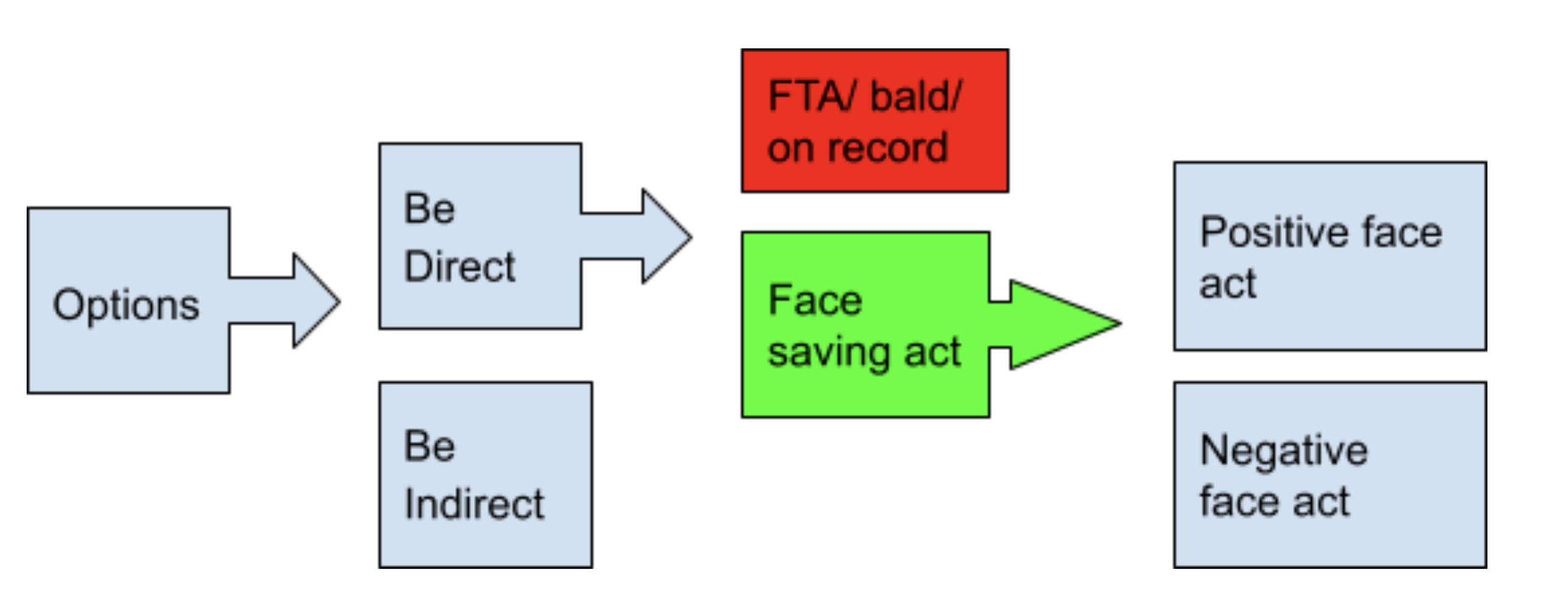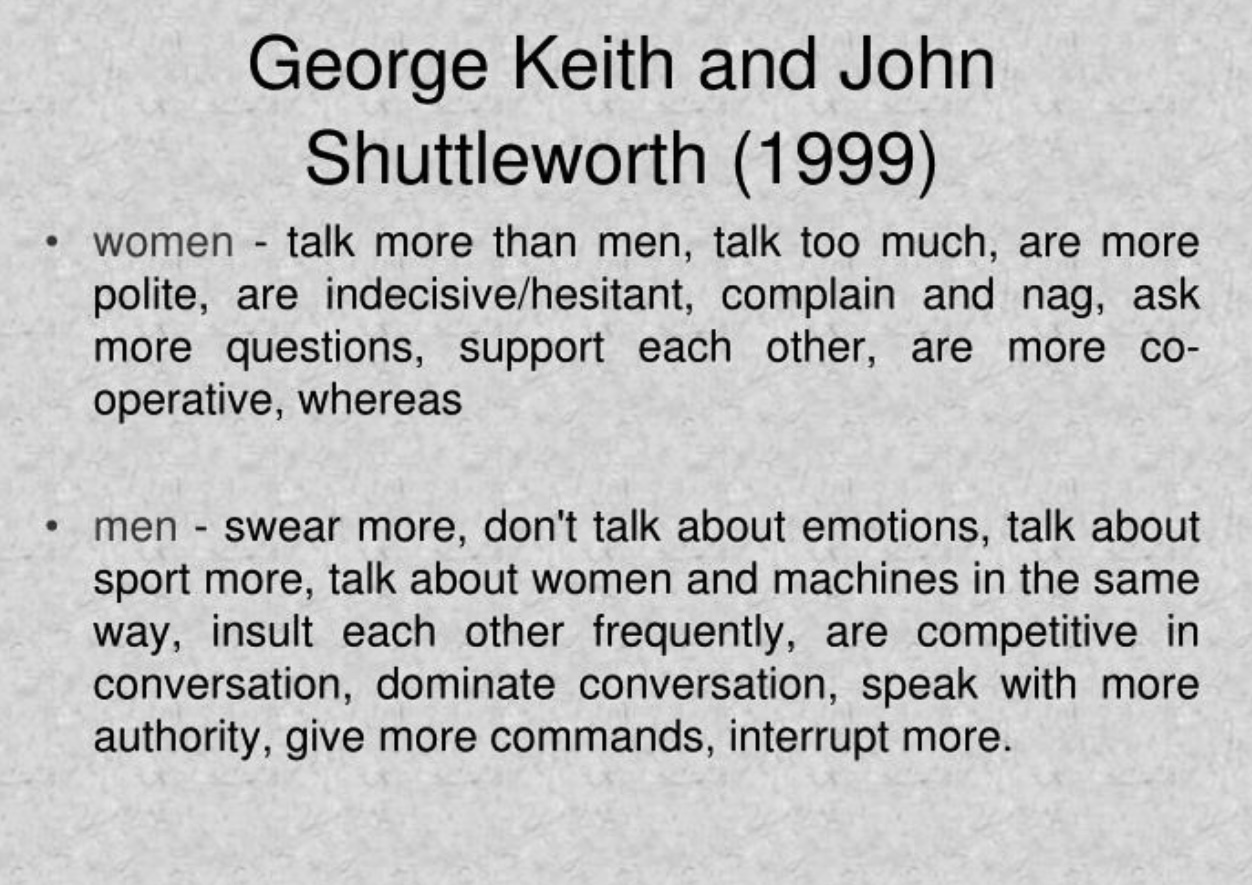Grice, Goffman and other blokes
5.0(1)
Card Sorting
1/15
Earn XP
Study Analytics
Name | Mastery | Learn | Test | Matching | Spaced |
|---|
No study sessions yet.
16 Terms
1
New cards
Name the 5 key theories you can apply
(Giles) Accommodation Theory
(Grice’s) Maxims of conversation
(Leech, Goffman) Politeness theory , maintains face
(Brown, Levinson) Face threatening acts
(Keith, Shuttleworth) Women and mens speech features
(Lakoff’s) Features of womens language
(Grice’s) Maxims of conversation
(Leech, Goffman) Politeness theory , maintains face
(Brown, Levinson) Face threatening acts
(Keith, Shuttleworth) Women and mens speech features
(Lakoff’s) Features of womens language
2
New cards
Speakers either comply and observe the maxims or fail to do so. What do we call this if a speaker does not comply?
Flouting- done deliberately and in a foregrounded way
Voilate- unintentionally or surreptitiously
Voilate- unintentionally or surreptitiously
3
New cards
What are the 4 maxims
Maxim of...
quality
quantity
relevance
manner
quality
quantity
relevance
manner
4
New cards
Quantity
Amount, speaking for the right amount of time and making a balanced conversation
5
New cards
Quality
Truth, speaking honestly and factually
6
New cards
Relevance
Staying on topic , not diverting the conversation
7
New cards
manner
Ambiguity, speaker avoids rambling, unclear replies
8
New cards
What are the two types of face needs
Positive face needs- needing to feel appreciated and valued
Negative face needs- desire to feel independent and not imposed upon
Negative face needs- desire to feel independent and not imposed upon
9
New cards
What is a face threatening act?
A speech act that has the potential to damage someone's self-esteem : When you challenge or infringe someone's positive or negative face needs
10
New cards
What is alignment?
Repeating back what is said as a form of affirmation. E.g
Derek: Are you sure?
Jane: I am sure.
Derek: Are you sure?
Jane: I am sure.
11
New cards
What is a politeness strategy?
Distinctive ways in which speakers can choose to speak to avoid FTAs
12
New cards
Different scales of politeness strategy impact how we respond, used to avoid FTAs, can you name all 5 forms of responses?
1) direct request with no politeness strategy
e.g turn that music down, its too loud
2) positive politeness strategy, often using hedging
E.g I love the band you're listening to but your music is a bit loud, would you mind turning it down
3) Negative politeness strategy , avoid ordering or imposing
e.g I'm sorry to ask you this but can you turn your music down
4) indirect request, avoids being explicit , more cryptic
e.g I really love this book I'm reading, shame its so noisy on this train.
5) inaction, not reacting at all in order to avoid confrontation
e.g turn that music down, its too loud
2) positive politeness strategy, often using hedging
E.g I love the band you're listening to but your music is a bit loud, would you mind turning it down
3) Negative politeness strategy , avoid ordering or imposing
e.g I'm sorry to ask you this but can you turn your music down
4) indirect request, avoids being explicit , more cryptic
e.g I really love this book I'm reading, shame its so noisy on this train.
5) inaction, not reacting at all in order to avoid confrontation

13
New cards
Name the 4 degrees of severity an FTA can occur.
Bald / on record Face threatening act
Indirect: Positive or negative face
Ignoring
Indirect: Positive or negative face
Ignoring
14
New cards
What are positive and negative face needs?
Positive- the need to feel appreciated and valued
Negative- the need to not feel imposed upon and independent
Negative- the need to not feel imposed upon and independent
15
New cards
Features of male and female language
(Shuttleworth)

16
New cards
Features of women’s language according to Lakoff
* Heading or fillers (sort of, well)
* Tag questions
* Intonation on declaratives
* Empty adjectives (lovely, charming)
* Precise colour terms (magenta)
* Intensifiers
* Standard English, hyper correct grammar
* Super polite forms ( euphemisms, indirectness)
* Avoidance of swearing (fudge)
* Prosodic stress
* Tag questions
* Intonation on declaratives
* Empty adjectives (lovely, charming)
* Precise colour terms (magenta)
* Intensifiers
* Standard English, hyper correct grammar
* Super polite forms ( euphemisms, indirectness)
* Avoidance of swearing (fudge)
* Prosodic stress